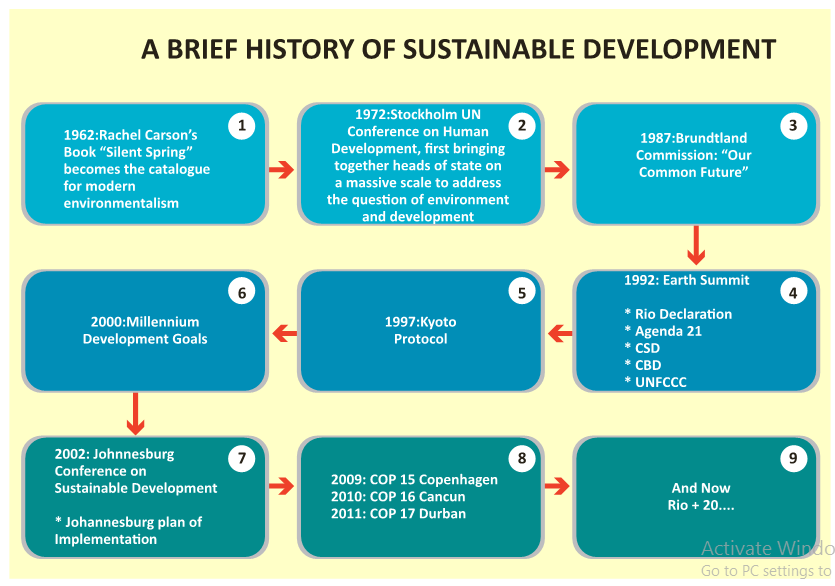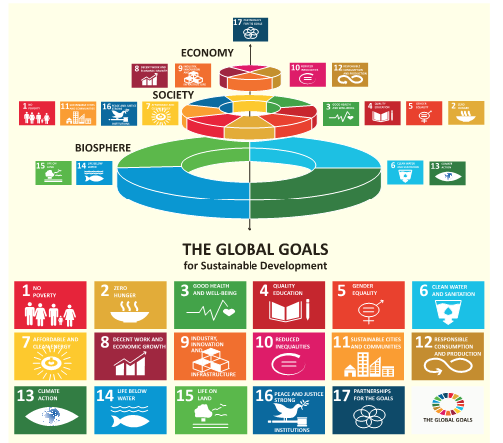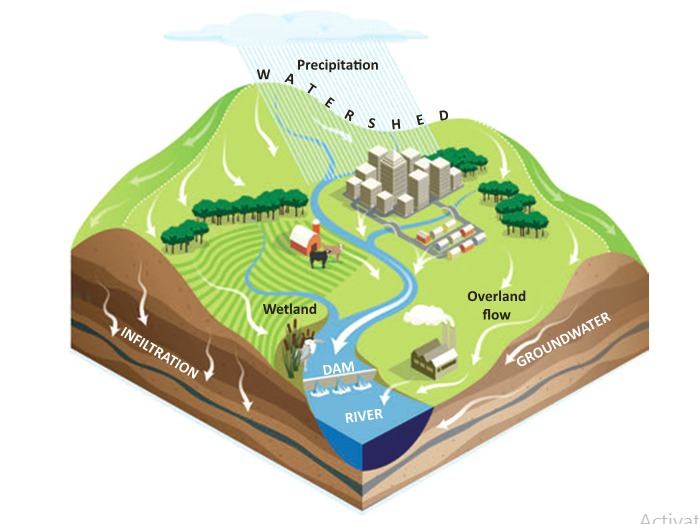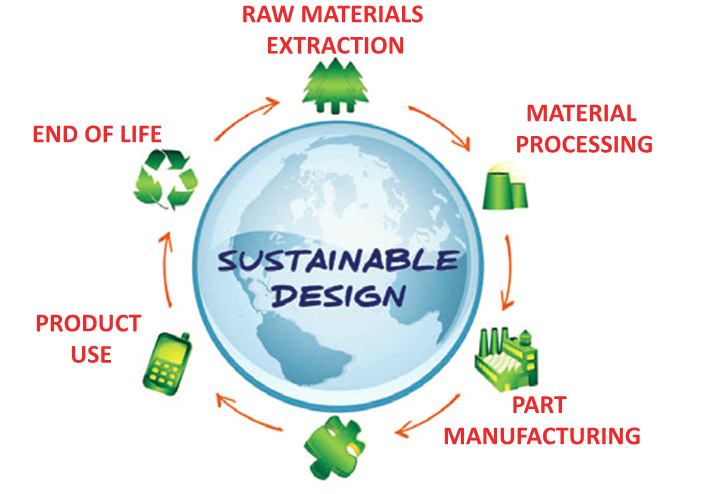Sustainable Development Notes 12th Geography
12th Geography Lesson 7 Notes in English
7] Sustainable Development
Introduction
- In the last few centuries there has been a drastic change in the lifestyle of man.
- Agricultural growth, industrialization, urbanization, rapid advancement in science and technology have decreased mortality rates and caused rapid growth of population over the earth.
- With increase in population there is an increase in the demand for natural resources leading to overuse, of nature and its resources.
- Nations began to wake up to the fact that the earth’s resources are depleting at an alarming rate and that something has to be done to sustain them.
- This led to develop the world in a sustainable way.
- Sustainability is supported by four pillars which are cultural vitality, economic health, environmental responsibility and social equity.
- All nations in the world focus on sustainable development as a major task.
United Nations and Sustainable Development
- Sustainability was first featured in the principles adopted by the United Nations Conference on the Human Environment held at Stockholm on 16 June 1972.
- It was now realized that development needed to be sustainable – it should not only focus on economic and social matters, but also on matters related to the use of natural resources.
- The United Nations commissioned a group of 22 people from both developed and developing countries to identify long-term environmental strategies for the international community.
- This World Commission on Environment and Development (WCED) was headed by Gro Harlem Brundtland, then the Prime Minister of Norway.
- This commission came to be known as the Brundtland Commission, which submitted its report, entitled Our common future, to the UN in 1987.
- The Brundtland Report focused on the needs and interests of humans.
- It was concerned with securing a global equity for future generations by redistributing resources towards poorer nations to encourage their economic growth in order to enable all human beings to achieve their basic needs.
- The report highlighted the three fundamental components of sustainable development, the environment, the economy, and society, which later became known as the triple bottom line.
- The 1992 and 2002 Earth Summits held at Rio de Janeiro and Johannesburg were the United Nations Conference on Environment and Development (UNCED), a direct result of the Brundtland Commission.
- An important achievement of the Rio summit was an agreement on the Climate Change Convention which led to the Kyoto Protocol which you have learned about earlier.
- The United Nations Conference on Sustainable Development (UNCSD), also known as Rio 2012, Rio+20 or Earth Summit 2012 was the third and recent International conference on sustainable development.
- It was hosted by Brazil in Rio de Janeiro from 13 to 22 June 2012.

Concept and Goals of Sustainable Development
- In 1980 the International Union for the Conservation of Nature introduced the term “sustainable development“.
- Sustainable development is development that meets the needs of the present without compromising the ability of future generations to meet their own needs.
- A primary goal of sustainable development is to achieve a reasonable and equitably distributed level of economic wellbeing that can be continued for many human generations.
Sustainable Development Goals (SDGs)
- In 1992, the UN Conference on Environment and Development published the Earth Charter, which outlined the building of a just, sustainable, and peaceful global society in the 21st century.
- The action plan was known as ‘Agenda 21’ for sustainable development.
- In September 2015, the United Nations General Assembly formally adopted the “Universal, integrated and transformative” 2030 Agenda for Sustainable Development, a set of 17 Sustainable Development Goals (SDGs).
- The goals are to be implemented and achieved in every country from the year 2016 to 2030.
- Countries adopted a set of goals to end poverty, protect the planet and ensure prosperity for all as part of a new sustainable development agenda.
- Each goal has specific targets to be achieved over the next 15 years.
- For the goals to be reached, everyone needs to do their part: governments, the private sector, civil society and people.
Goal 1: End poverty in all its forms everywhere
- One in five people in developing countries still live on less than $1.90 a day, many people risk slipping back into poverty.
- Economic growth must be inclusive to provide sustainable jobs and promote equality.
Goal 2: End hunger, achieve food security and improved nutrition and promote sustainable agriculture
- Agriculture, forestry and fisheries can provide nutritious food for all and generate decent incomes, while supporting people- centred rural development and protecting the environment.
- A profound change of the global food and agriculture system is needed if we are to nourish today’s 815 million hungry and the additional 2 billion people expected by 2050.

Goal 3: Ensure healthy lives and promote well-being for all at all ages
- Significant strides have been made in increasing life expectancy and reducing some of the common killers associated with child and maternal mortality.
- Major progress has been made on increasing access to clean water and sanitation, reducing malaria, tuberculosis, polio and the spread of HIV/AIDS.
Goal 4: Ensure inclusive and quality education for all and promote lifelong learning
- Major progress has been made towards increasing access to education at all levels and increasing enrolment rates in schools particularly for women and girls.
- For example, the world has achieved equality in primary education between girls and boys, but few countries have achieved that target at all levels of education.
Goal 5: Achieve gender equality and empower all women and girls
- Gender equality is not only a fundamental human right, but a necessary foundation for a peaceful, prosperous and sustainable world.
Goal 6: Ensure access to water and sanitation for all
- Clean, accessible water for all is an essential part of the world we want to live in.
- There is sufficient fresh water on the planet to achieve this.
- But due to bad economics or poor infrastructure, every year millions of people, most of them children, die from diseases associated with inadequate water supply, sanitation and hygiene.
- By 2050, at least one in four people is likely to live in a country affected by chronic or recurring shortages of fresh water.
Goal 7: Ensure access to affordable, reliable, sustainable and modern energy for all
- Energy is central to nearly every major challenge and opportunity the world faces today.
- Sustainable energy is opportunity – it transforms lives, economies and the planet.
Goal 8: Promote inclusive and sustainable economic growth, employment and decent work for all
- Sustainable economic growth will require societies to create the conditions that allow people to have quality jobs that stimulate the economy while not harming the environment.
- Job opportunities and decent working conditions are also required for the whole working age population.
Goal 9: Build resilient infrastructure, promote sustainable industrialization and foster innovation
- Inclusive and sustainable industrial development is the primary source of income generation, allows for rapid and sustained increases in living standards for all people, and provides the technological solutions to environmentally sound industrialization.
Goal 10: Reduce inequality within and among countries
- To reduce inequality, policies should be universal in principle paying attention to the needs of disadvantaged and marginalized populations.
Goal 11: Make cities inclusive, safe, resilient and sustainable
- Cities are hubs for ideas, commerce, culture, science, productivity, social development and much more.
- At their best, cities have enabled people to advance socially and economically Common urban challenges include congestion, lack of funds to provide basic services, a shortage of adequate housing and declining infrastructure.
Goal 12: Ensure sustainable consumption and production patterns
- Sustainable consumption and production is about promoting resource and energy efficiency, sustainable infrastructure, and providing access to basic services, green and decent jobs and a better quality of life for all.
- Its implementation helps to achieve overall development plans, reduce future economic, environmental and social costs, strengthen economic competitiveness and reduce poverty.
Goal 13: Take urgent action to combat climate change and its impacts
- Climate change is now affecting every country on every continent.
- It is disrupting national economies and affecting lives, costing people, communities and countries dearly today and may be even more tomorrow.
Goal 14: Conserve and sustainably use the oceans, seas and marine resources
- The world’s oceans – their temperature, currents and life – drive global systems that make the earth habitable for humankind.
- Careful management of this essential global resource is a key feature of a sustainable future.
Goal 15: Sustainably manage forests, combat desertification, halt and reverse land degradation, halt biodiversity loss
- Forests cover 30 per cent of the Earth’s surface and in addition to providing food security and shelter, forests are key to combating climate change, protecting biodiversity and the homes of the indigenous population.
- Thirteen million hectares of forests are being lost every year while the persistent degradation of dry lands has led to the desertification of 3.6 billion hectares.
Goal 16: Promote just, peaceful and inclusive societies
- This Goal is dedicated to the promotion of peaceful and inclusive societies for sustainable development, the provision of access to justice for all, and building effective, accountable institutions at all levels.
Goal 17: Revitalize the global partnership for sustainable development
- A successful sustainable development agenda requires partnerships between governments, the private sector and civil society.
- These inclusive partnerships built upon principles and values, a shared vision, and shared goals that place people and the planet at the centre, are needed at the global, regional, national and local level.
Climate Change and Sustainability
- The Earth’s climate has changed throughout history.
- In the last 650,000 years there have been several cycles of glacial and warm periods each lasting thousands or millions of years.
- Most of these climate changes are attributed to very small variations in earth’s orbit that changes the amount of solar energy our planet receives.
- It is understood that at present the Earth’s climate is getting warmer which is referred to as ’Global Warming’.
- Earth’s temperature has gone up about one degree Fahrenheit in the last 100 years.
- This is a very small change but small changes in earth’s temperature can have big effects.
- Some effects are already happening such as melting of glaciers, rise in the level of oceans, prolonged droughts, excessive rain and floods, etc.
Reasons for Climate change
- Burning fossil fuels emits gases into the atmosphere.
- Burning fossil fuel to provide energy, coupled with the effects of major transportation and deforestation causes a rapid increase in global temperatures.
- This can change the climate of a place.
- Effects of climate change – Scientists had predicted in the past that the result from global climate change are now occurring, loss of sea ice, accelerated sea level rise and longer, more intense heat waves.
1. Temperatures will continue to rise – Experts agree that greenhouse gases which trap heat and prevent it from leaving the earth’s atmosphere are mostly responsible for the temperature spike.
2. Frost- free season (and growing season) will lengthen – it could actually have detrimental effects on the crops we grow.
Warmer weather helps pests survive longer which can destroy crops.
Rising temperatures are also expected to contribute to a shift in areas which are agriculturally most productive and the crops that grow there.
3. Changes in precipitation patterns – The contrast between wet and dry areas will increase globally.
In other words, the wet areas will get wetter and the dry areas will get drier.
4. More droughts and heat waves – With rising temperatures and shifting rainfall patterns, heat waves and droughts are increasing in frequency and intensity.
6. Sea level rise – Scientists have determined that global sea level has been steadily rising since 1900 at a rate of at least 0.1 to 0.25 centimeter per year.
Sea level can rise by two different mechanisms with respect to climate change.
7. Arctic likely to become ice-free – The Arctic Ocean is expected to become essentially ice free in summer before mid-century.
Response to Climate Change
- There are two main responses to climate change.
- Mitigation – which addresses the root causes of climate change, by reducing greenhouse gas emissions.
- Adaptation – seeks to lower the risks posed by the consequences of climatic changes.
- Both approaches will be necessary to deal with the global changes that have already been set in motion.
Mitigation measures:
- It is important that we learn how to reduce climate change, and put them into practice now, before it is too late.
- Cleaner alternative energy sources: One important way to fight climate change is to reduce our reliance on and usage of fossil fuels, and depend on alternative renewable and greener sources of energy such as wind energy, solar energy, water or hydropower, biomass, and geothermal energy.
- Energy saving tips – we can adopt energy saving tips by investing in more expensive energy-saving appliances like the compact fluorescent light (CFL) bulbs, Air- conditioners, refrigerators etc.
- Switching off our electrical appliances when not in use.
- Green driving tips – The best strategy to reduce toxic gas emissions is definitely to reduce the use of automobiles.
- Use public transport, carpooling, use of electricity powered cars or two wheelers can be an alternative.
- Reduce – Reuse – Recycle practices – Reducing, reusing and recycling helps us conserve resources and energy, and reduce pollution and greenhouse gas emissions produced thereby.
- Re-forestation – The cleanest and most efficient remover of carbon dioxide from our atmosphere actually is nothing but green plants and trees.
- The rate at which we are cutting down our trees and forests to make way for human developments has greatly reduced the earth’s ability to remove carbon dioxide from the atmosphere.
- Organic farming – Soils are an important sink for atmospheric carbon dioxide. Nevertheless, deforestation making way for conventional agriculture is increasingly depleting this sink.
- Sustainable and organic agriculture helps to counteract climate change by restoring soil organic matter content as well as reduce soil erosion and improve soil physical structure.
- Organic farming uses natural fertilizers and helps maintain crop yields.
Watershed management and its importance
- Watershed is a geographical area drained by a stream or a system connecting stream in which water from all over an area flow under gravity to a common drainage channel.
- A watershed system delivers water through rills, gullies and streams to a larger body of water.
- Watershed management is proper utilization of land and water resource for optimum production with minimum hazards to natural resources.
- It relates to soil and water conservation proper land uses, promote afforestation and sustainable farming practices, conserve farmland and pastureland, maintaining soil fertility, proper management of local water for farming, drainage, construct small dams for flood protection, improving individuals standard of living and thereby promote ecological balance.
Key steps in watershed management
- Watershed plans should first identify the characteristics of the watershed and inventory the watershed’s natural resources.

- The first steps in watershed management planning are to:
- Delineate and map the watershed’s boundaries and the smaller drainage basins within the watershed.
- Map and prepare an Inventory of resources in the watershed.
- Prepare an Inventory and map the natural and manmade drainage systems in the watershed.
- Prepare an Inventory and map land use and land cover.
- Prepare a soil map of the watershed.
- Identify areas of erosion, including stream banks and construction sites.
- Identify the quality of water resources in the watershed as a baseline; and
- Prepare a map and Inventory of pollution sources, both point sources (such as industrial discharge pipes) and nonpoint sources (such as municipal storm water systems, failing septic systems, illicit discharges).
Watershed Management in India:
- Watershed development project in the country has been sponsored and implemented by Government of India from early 1970s onwards.
- Various watershed development programs like Drought Prone Area Program (DPAP), Desert Development Program (DDP), River Valley Project (RVP), National Watershed Development Project for Rain-fed Areas (NWDPRA) and Integrated Wasteland Development Program (IWDP) were launched subsequently in various hydro-ecological regions.
- Entire watershed development programs primarily focused on soil conservation and rainwater harvesting during 1980s and before.
Rain Water Harvesting (RWH)
- Millions of people throughout the world do not have access to clean water for domestic purposes.
- In many parts of the world conventional piped water is either absent, unreliable or too expensive.
- One of the biggest challenges of the 21st century is to overcome the growing water shortage.
- Rain Water Harvesting (RWH) has thus regained its importance as a valuable alternative or supplementary water resource, along with more conventional water supply technologies.
- Water shortages can be relieved if rain water harvesting is practiced more widely.
Need for Rain Water Harvesting
- To overcome the situation of inadequacy of water supply.
- The most economical way to increase the ground water table.
- To replenish the sub soil of the urban area covered with pavements.
- To recharge the underground water table at places where the availability of rain water is higher or to overcome the situation of water logging.
- Rain water harvesting also improves the quality of underground water through a process called dilution.
- To get water for irrigation of greenbelts, farms, gardens, etc.
Rain Water Harvesting Techniques
- There are two main techniques of rain water harvestings:
- Storage of rain water on surface for future use.
- Recharge to ground water.
- The storage of rain water on surface is a traditional technique and structures used were underground tanks, ponds, check dams, weirs, etc.
- Recharge of ground water is a new concept of rain water harvesting and the structures generally used are:
- Recharge pits filled with boulders, gravels, and coarse-sand, Wells, Trenches etc.
Environmental Impact Assessment
- Every country strives to progress ahead.
- One aspect of progress is economic development through manufacturing and trading.
- Every country builds industries which provide employment, serve the consumers needs and help to generate revenue.
- The dominant pattern of development that humankind has followed in recent decades has brought about large scale changes in the earth systems.
- We are already feeling the impact of these changes upon our health, livelihoods and safety.
- On the other hand, the fruits of development are not equally distributed.
- Some countries and some communities have a high standard of living, while others are not able to meet their basic needs.
- Development projects in the past were undertaken without any consideration about their environmental consequences.
- As a result rivers and lakes have been polluted, air pollution has reached threatening levels and pilling of domestic and industrial wastes has resulted in land degradation.
- Industrialization and economic growth provided material comforts but at the same time deteriorated the quality of life.
The Objective of EIA
- To identify, predict and evaluate the economic, environmental and social impact of development activities
- To provide information on the environmental consequences for decision making and
- To promote environmentally sound and sustainable development through the identification of appropriate alternatives and mitigation measures.
Steps in the EIA Process
- The eight steps of the EIA process:
- Screening: First Stage of EIA, which determines whether the proposed project, requires an EIA and if it does, then the level of assessment required.
- Scoping: This stage identifies the key impacts that should be investigated. This stage also defines the time limit of the study.
- Impact analysis: This stage of EIA identifies and predicts the likely environmental and social impact of the proposed project and evaluates the significance.
- Mitigation: This step in EIA recommends the actions to reduce and avoid the potential adverse environmental consequences of development activities.
- Reporting: This stage presents the result of EIA in a form of a report to the decision- making body and other interested parties.
- Review of EIA: It examines the adequacy and effectiveness of the EIA report and provides the information necessary for decision –making.
- Decision-making: It decides whether the project is rejected, approved or needs further change.
- Post monitoring: This stage comes into play once the project is commissioned.
- It checks to ensure that the impacts of the project do not exceed the legal standards and implementation of the mitigation measures are in the manner as described in the EIA report.
Environmental Impact Assessment in India
- EIA was introduced in India in 1978, with respect to river valley projects.
- On 27 January 1994, the Union Ministry of Environment and Forests (MEF), Government of India, under the Environmental (Protection) Act 1986, made Environmental Clearance (EC) mandatory for expansion or modernisation or for setting up new projects listed in Schedule 1 of the notification.
- Since then there have been 12 amendments made in the EIA notification of 1994.
- Both central and state authorities share the responsibility of EIA’s development and management.
- EIA is now mandatory for 30 categories of projects, and these projects get Environmental Clearance (EC) only after the EIA requirements are fulfilled.
- The MoEF recently notified new EIA legislation in September 2006.
- The notification makes it mandatory for all projects to get environment clearance from the central government under the following categories:
- Industries
- Mining
- Thermal power plants
- River valley projects
- Infrastructure and CRZ (Coastal Regulation Zone)
- Nuclear power projects.

- However, the new legislation has entrusted the decision of clearing projects on the state government depending on the size/ capacity of the project.
- EIA appraises the environmental health and social implications of planned developmental projects.
- It thus links environment with development.
- The goal of EIA is to ensure environmentally safe and sustainable development.
Measures for Promotion of Sustainable Development
- As discussed earlier, the United Nations 17 Sustainable Development Goals and 169 targets are part of the 2030 Agenda for Sustainable Development adopted by 193 Member States at the UN General Assembly Summit in September 2015, and which came into effect on 1 January 2016.
- These goals are the result of international consultations that brought national governments and millions of citizens from across the globe together to negotiate and adopt the global path to sustainable development for the next 15 year.
- The SDGs and targets will stimulate action in the following critically important areas: poverty, hunger, education, health and well- being, education, gender equality, water and sanitation, energy, economic growth and decent work, infrastructure, industry and innovation, reducing inequalities, sustainable cities, consumption and production, climate action, ecosystems, peace and justice, and partnership.
- This agenda recognises that it is not enough to focus on economic growth alone but in creating more equal societies, and a safer and more prosperous planet.
Which countries are achieving the UN Sustainable Development Goals fastest?
- The ultimate aim of the Sustainable Development Goals is to end poverty, protect the planet and ensure prosperity for everyone.
- Each goal has specific targets that need to be met by 2030.
- So how close are countries to meeting them?
- To find out, non-profit organization Bertelsmann Stiftung and the UN Sustainable Development Solutions Network have created a prototype index that measures their performance.
- Sweden leads the list, followed by Denmark and Finland.
- Among the G7 countries, only Germany and France can be found among the top ten performers.
- The United States ranks 42nd on the Index, while Russia and China rank 62nd and 71st respectively.
- Also in the top 20 were Canada (13th), the Czech Republic (15th) and Slovenia (17th).
- Asia-Pacific’s top performers Japan, Singapore and Australia rounded off the list at 18th, 19th and 20th, respectively.
- The SDG Index underlines that despite achieving high percentages, all countries still have their work cut out to close the remaining gap.
- India ranks 116 out of 157 nations on a global index that assesses the performance of countries towards achieving the ambitious sustainable development goals (SDGs).
MORE TO KNOW:
Paris Agreement
- To address climate change, countries adopted the Paris Agreement at the COP21 in Paris on 12 December 2015.
- The Agreement entered into force shortly thereafter, on 4 November 2016.
- In the agreement, all countries agreed to work to limit global temperature rise to well below 2°C, and given the grave risks, to strive for 1.5°C.
UNFCCC Process for Climate Change Adaptation, On17, May 2017:
- Policy makers, implementers, supporters and investors from all over the world met during the UNFCCC Bonn Climate Change Conference at the Technical Expert Meeting (TEM) on Adaptation to discuss ‘Integrating climate change adaptation with the Sustainable Development Goals and the Sendai Framework for Disaster Risk Reduction.
Baripada: A hamlet that conserves forest, promotes growth

- Baripada, a small hamlet straddling the Maharashtra-Gujarat border, is a collective tribal wisdom which has taken it to the next level.
- With a population of barely 1,000, the village has not only helped conserve their forest but also meet the United Nations’ sustainable development goals, benefiting everyone in the process.
- The villagers conserved the forest.
- And, forest helped in conservation of water. Water enabled agriculture and farming.
- Farming brought prosperity, which in turn helped improve literacy.
- And, literacy broadened horizons and led us to total transformation.
- Having developed dairy and poultry over the years, the villagers have also evolved a system for marketing their products.
- This ensured a steady flow of revenue and kept poverty at bay.
- The villagers share their common land with landless families to ensure ‘zero hunger’ and ‘reduction of inequality’.
- Besides, the villagers are game for any experiments involving water, land, forest conservations, biodiversity registration, biogas, solar power, building basic infrastructure through public participation.
- “Decisions on prohibition, tree plantation were made at the village meeting and immediately implemented.
- But, to restrict entry of humans and animals in the 445 hectares of village forest was a major task”.
